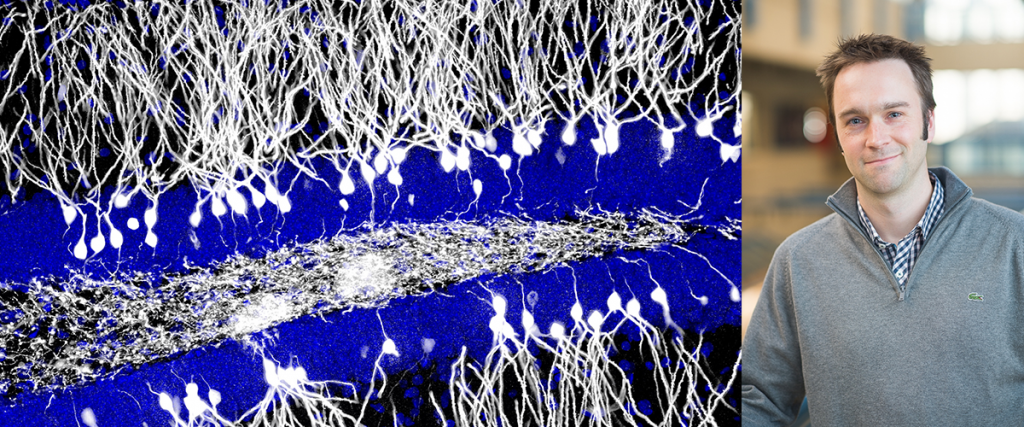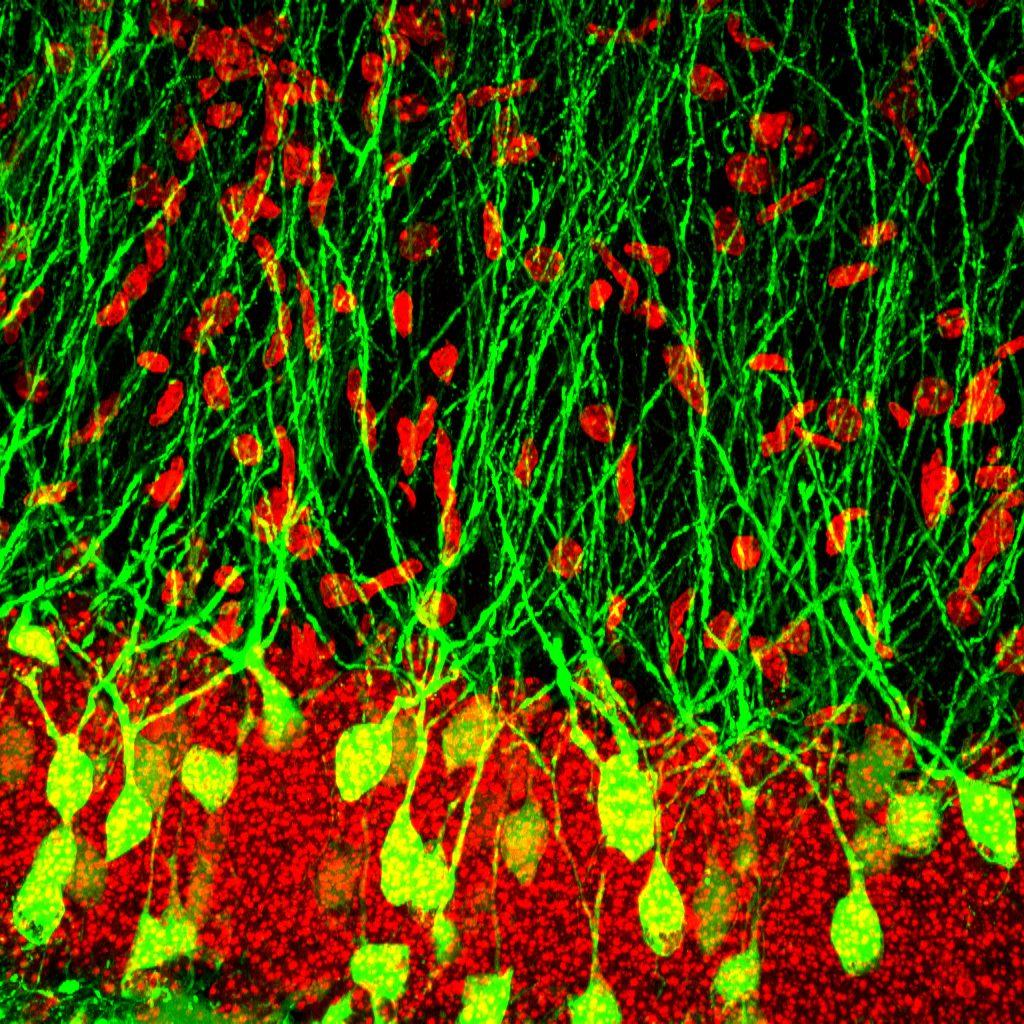

Through the lens of adult neurogenesis, Dr. Jason Snyder’s lab explores how the brain stores information and uses it to guide future behaviour. The lab investigates the role of neurogenesis in both the memory and mood related functions of the hippocampus, including the possibility that memory-related functions may be dependent on emotional factors such as stress.
In this Q&A with Dr. Snyder, we learn how he developed an interest in this fascinating research–and the research taking place in the lab. Plus, the Snyder Lab shares some images of newborn neurons in the rat hippocampus.
To start with, what is adult neurogenesis?
Adult neurogenesis is the addition of new neurons (brain cells) to the adult brain. We all know that you can heal a cut by growing new skin cells but traditionally it has been assumed that the brain is not capable of such repair, and that it cannot produce new neurons beyond early childhood. Fortunately we come equipped with helmets (our skulls!). But neurons can still die with age or in response to trauma or neurodegenerative disease. And in depression brain cells may not necessarily die but they can shrink. Amazingly, it turns out that the brains of animals and humans can produce new neurons in adulthood. Are they important for restoring brain function and mental health? The short answer is we don’t know, but we think so!
When and why did you first develop an interest in adult neurogenesis?
My career began probably in a very similar way to many undergraduate students who are interested in neuroscience and behaviour: through courses and volunteering in a lab. Actually, we could step back a bit – I spent much of my youth in the pool as a competitive swimmer. I became fascinated (and sometimes frustrated) with the way my body could on some days power through a two hour workout, yet on others my muscles would feel tight and wouldn’t budge no matter how hard I tried. I figured there must be a reason. And while I never really pursued that problem, academically, it is the same sort of biological curiosity that made me want to do a project on “How the hippocampus stores memories” in my third year of undergrad. I had no concept of how memories might have a biological basis but by consulting with a neurophysiologist in the department (Martin Wojtowicz) I learned about synaptic plasticity as a cellular model of memory. After writing up a report he read it, I remained fascinated, and he invited me to study synaptic plasticity in newborn neurons in his lab. Something no one had ever investigated in the world EVER! What an opportunity, in my fourth year! I went on the do a PhD with him and the rest is history.
What’s the lab’s main research focus?
Our main focus is how experience alters neuronal function and guides future behaviour. We have traditionally been interested in the role of newborn neurons in hippocampal-dependent memory for daily events. However, memory is important for much more than remembering where you left your toenail clippers. It shapes how you respond to future experiences, how you distinguish related experiences, and how you identify the commonalities between different experiences. And so we are interested in memory but also how experience alters emotional processes and decision making. On the cellular level, we believe newborn neurons are important but they don’t act in isolation. We are therefore interested in how they interact with other neurons in the hippocampus and more generally how circuits and synapses function to translate experience into behavioural changes.
What are other members of your lab working on?
Shaina Cahill is a PhD student who is not looking at adult neurogenesis, but developmental neurogenesis. Shaina has found that neurons born in infancy in the rat actually die throughout young adulthood. We think this is part of a natural aging process and may play a role in forgetting and memory turnover.
Desiree Seib is a postdoctoral fellow who has found that blocking adult neurogenesis causes rats to choose a small immediate reward instead of a larger but delayed reward. This implicates neurogenesis in a number of disorders that are characterized by impulsivity and immediate gratification.
Tim O’Leary is a postdoctoral fellow who has found that blocking neurogenesis alters memory mainly as a function of stress. Interestingly, male rats without neurogenesis learn better under low stress conditions, but female rats without neurogenesis learn better under high stress.
Ru Qi Yu is a graduate student in Jiaying Zhao’s lab who is collaborating with us, investigating the role of neurogenesis in pattern detection. Juliane Coutts is a graduate student co-supervised by Neil Cashman who is investigating strategies for boosting neurogenesis in Alzheimer’s disease.
A number of undergrads are also doing super exciting projects investigating: the role of neurogenesis in Alzheimer’s disease (Delane Espinueva and John Darby Cole), the occurrence of neurogenesis in the brain’s reward circuitry (Jerry Yang), the role of neurogenesis in memory for objects in specific places (Erin Chahley) and new quantitative methods for studying spatial navigation (Matt Cooke).
Can you tell us about any new research that you are particularly excited about?
Honestly, I’m super excited about all of it! However, whereas much of our work has utilized a transgenic rat where we can block neurogenesis more or less permanently, we have developed virus-based methods for selectively silencing neurons of different ages. I think this will be a powerful tool for identifying whether new neurons perform similar or different functions from older neurons. This is exciting to me because relatively little is known about what different aged neurons are doing. It may be useful down the road for therapies. For example, if we find that new and old neurons have the same circuit and behavioural functions, then adding new neurons may be able to fix a brain that has lost older neurons. In contrast, if they perform different functions, we may need to think about saving the older neurons.
You have a large number of humans working in the lab. Can you describe the personality of the lab?
I suppose it is a mix in terms of research experience, from very junior to very advanced. But everyone plays a key role in advancing the research, they just operate at different levels, and evolve into distinct roles as they are ready.
I feel incredibly fortunate to have been able to grow a lab that is filled with genuinely nice people who are fun to work with and who work hard. I also have to say that I think that everyone, no matter how junior, should have the ability to share/publish their research somehow with the world. Because no matter how “small” a finding or a method is to you, it may be useful for someone else. And so that is something we always try to promote.
Watch a portrait of the lab:
Lastly, what does the lab do for fun?
I’ve found that the best predictor of research success is a strong background in curling, which is like Canada’s national sport or something. And so no one joins the lab unless they have 1000+ hours of curling ice time under their belt. Okay, fine, maybe I make a few exceptions here or there. Okay, fine, no one actually curls except once a year around Christmas we bash rock on the ice and I take a ton of pictures of the event. So, that’s one thing.
Images of newborn neurons in the rat hippocampus, captured by the Snyder Lab










